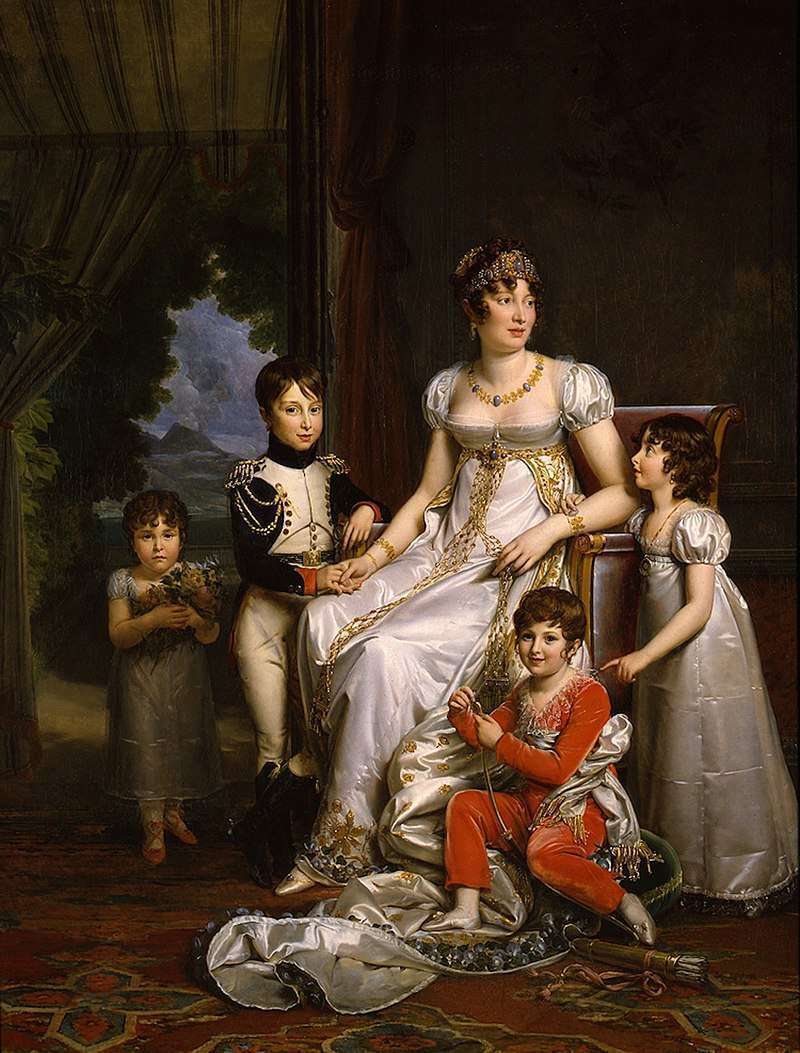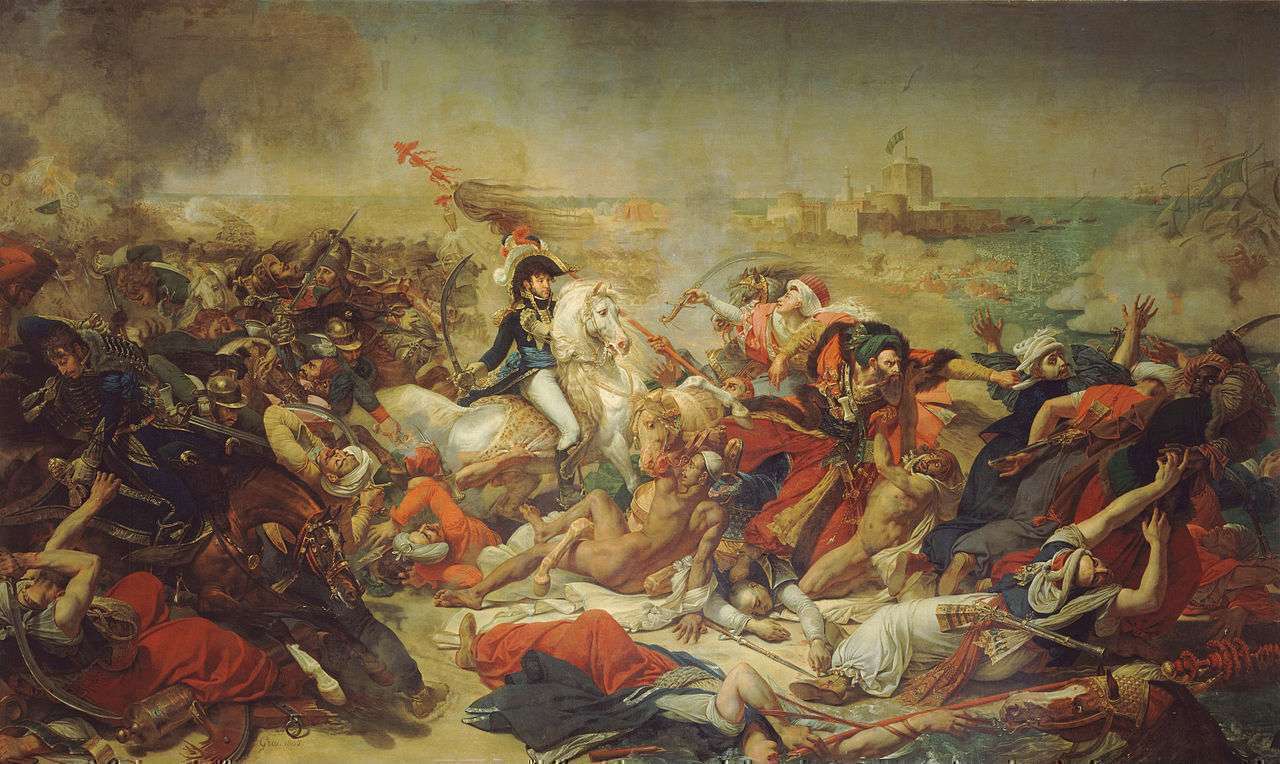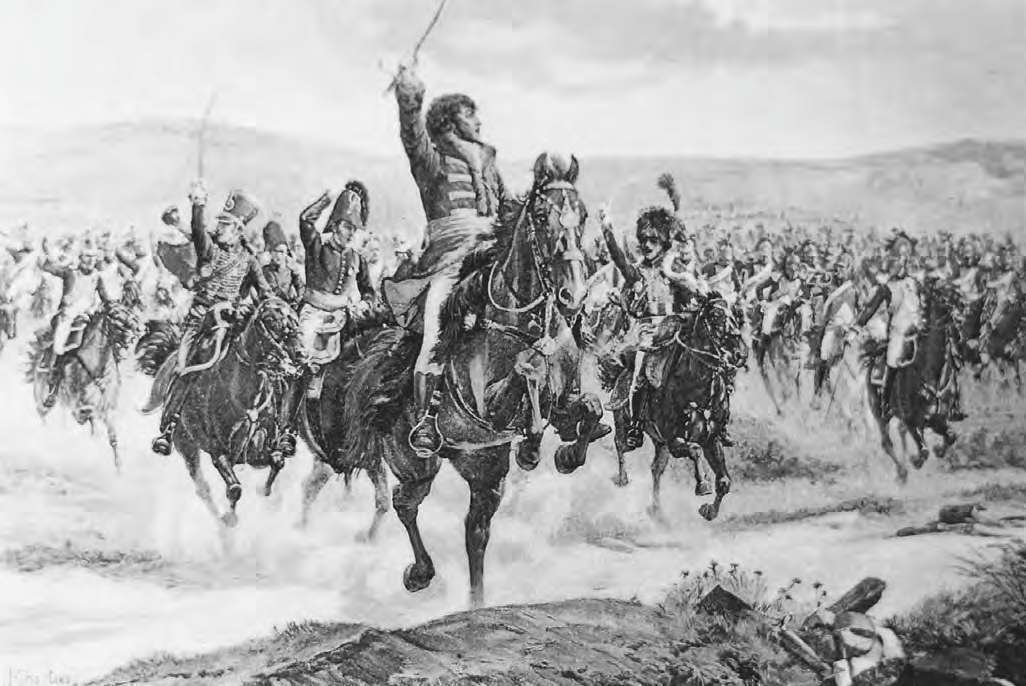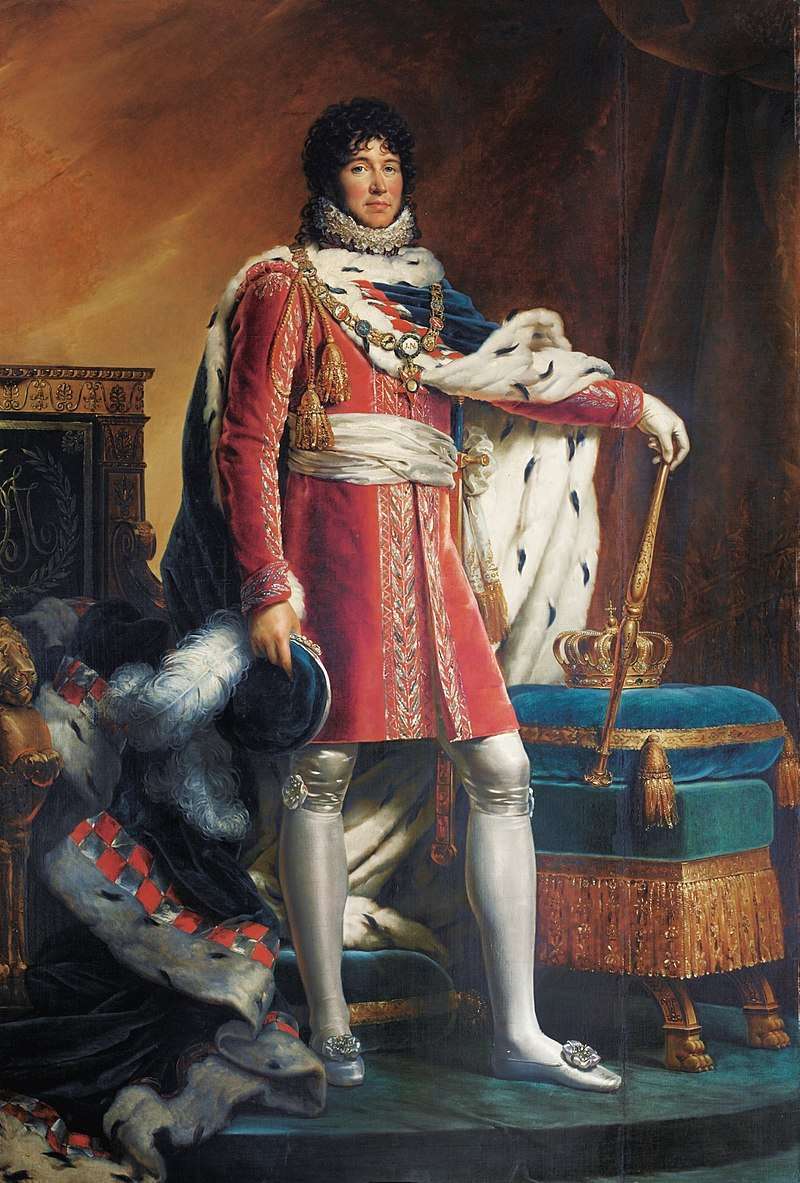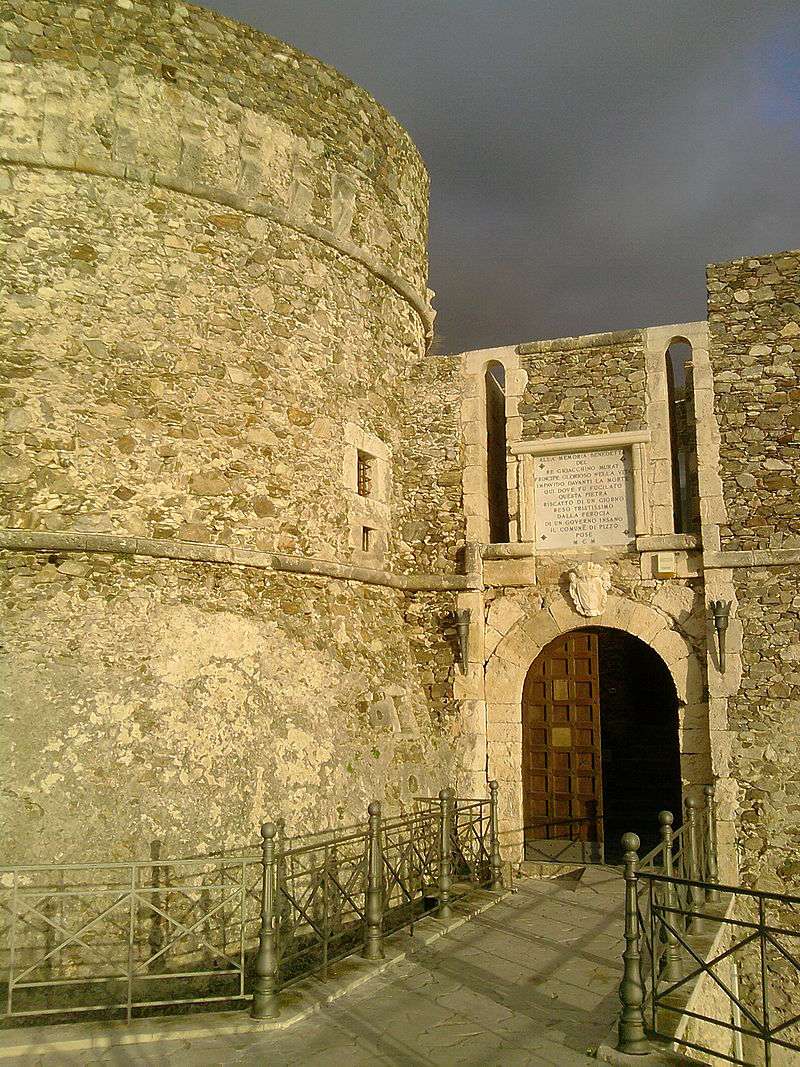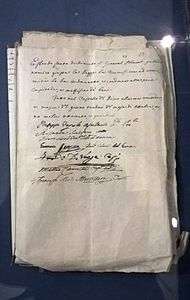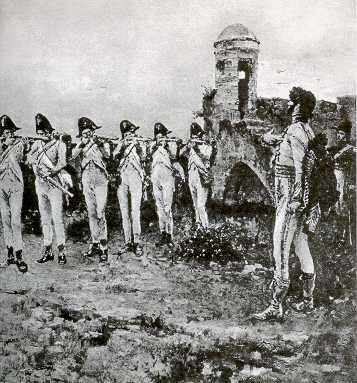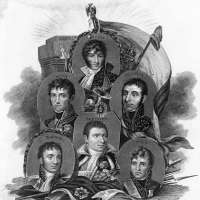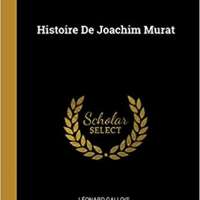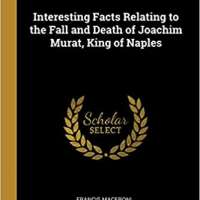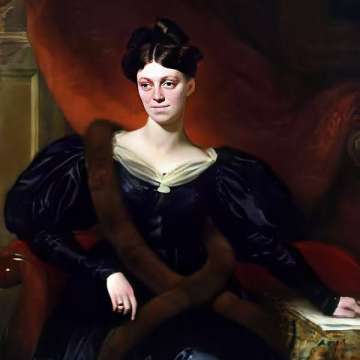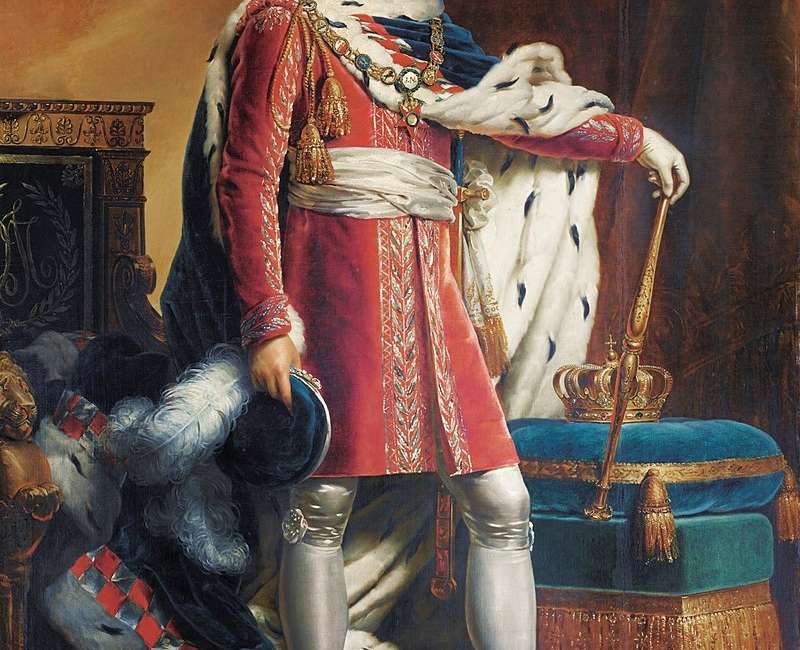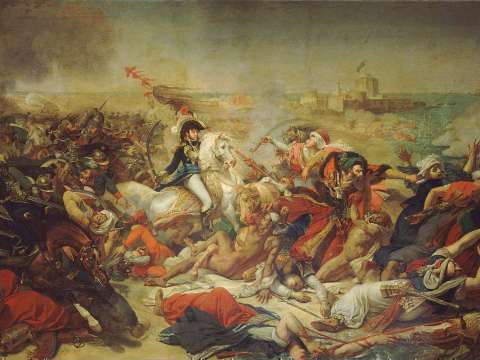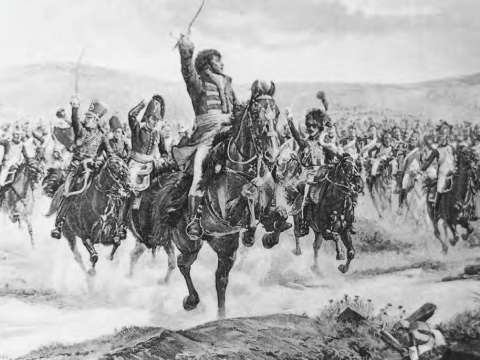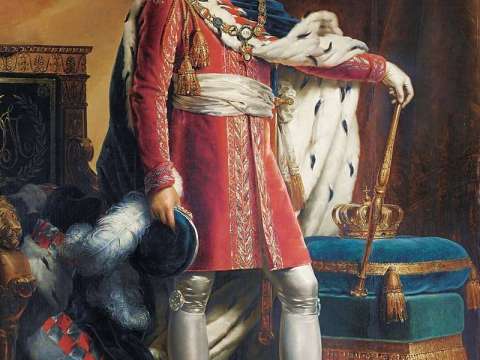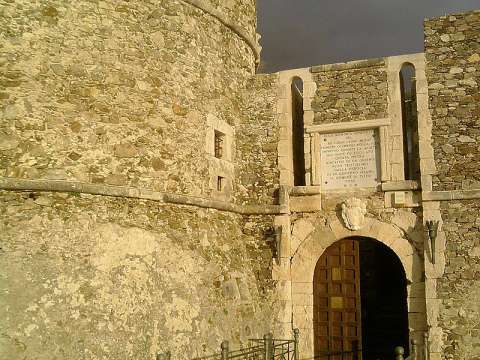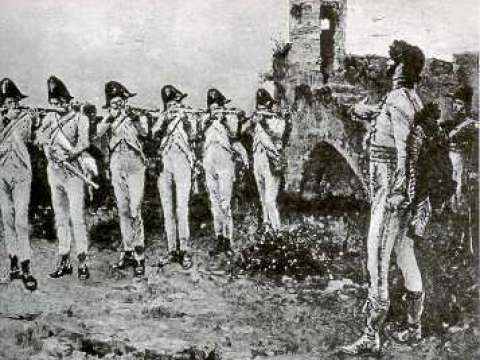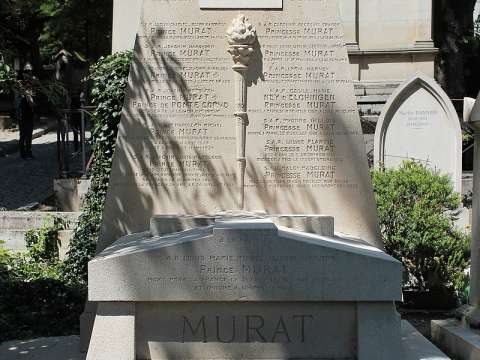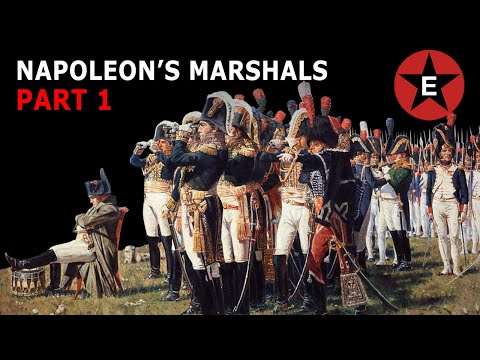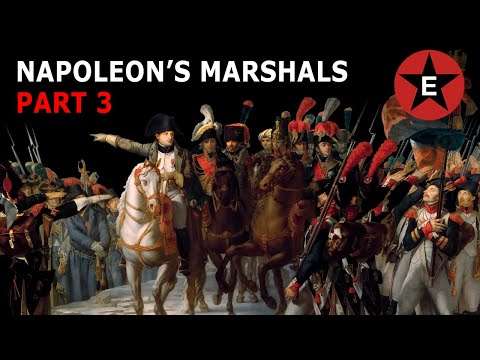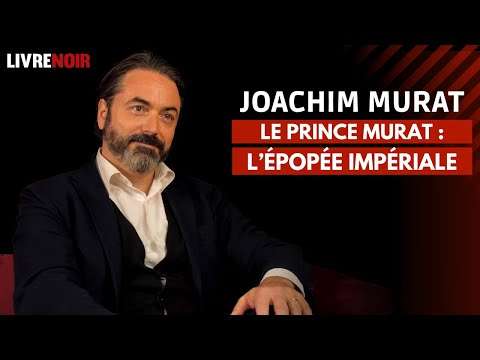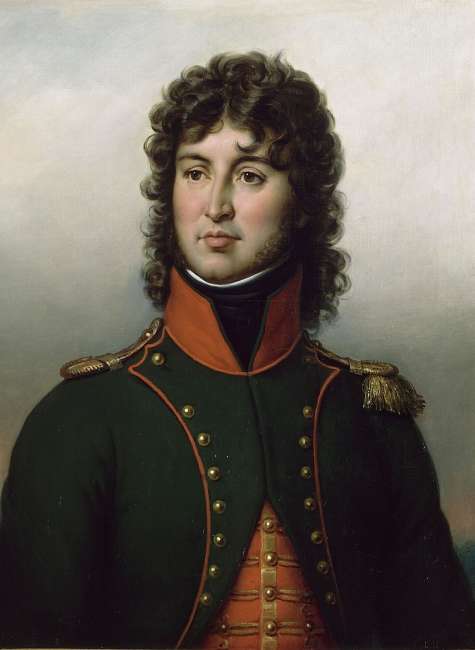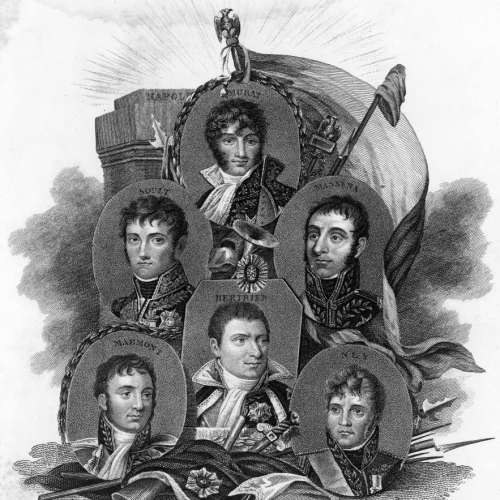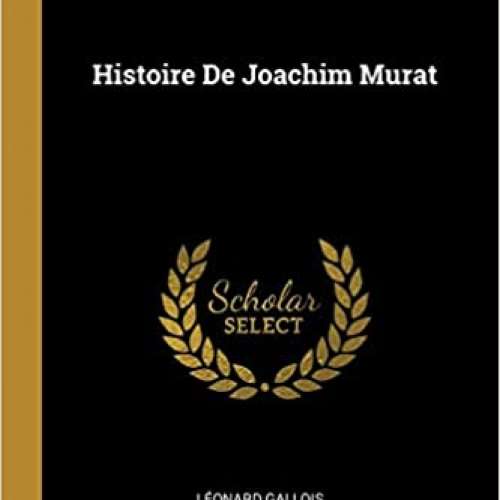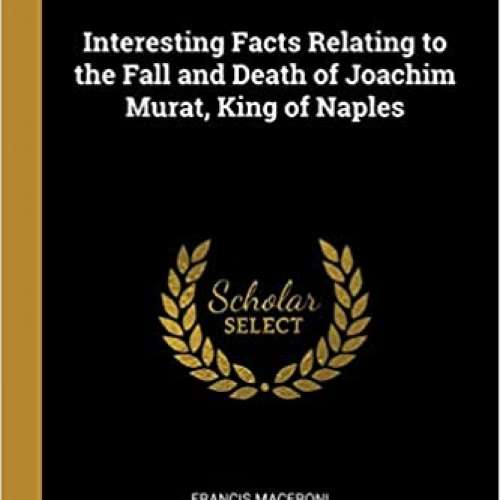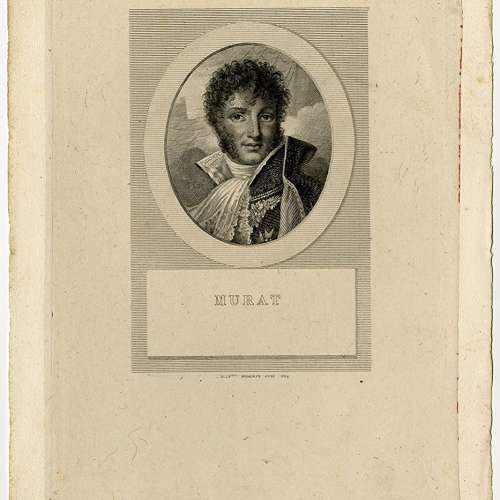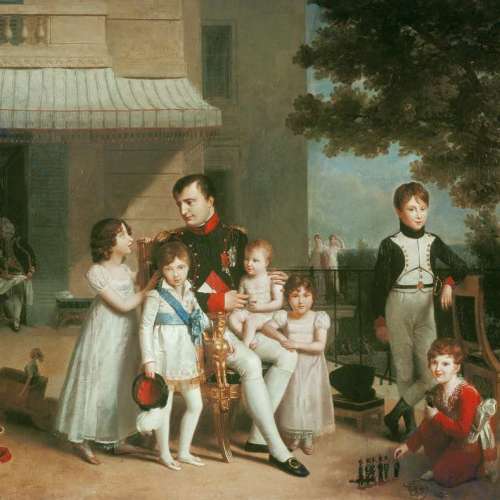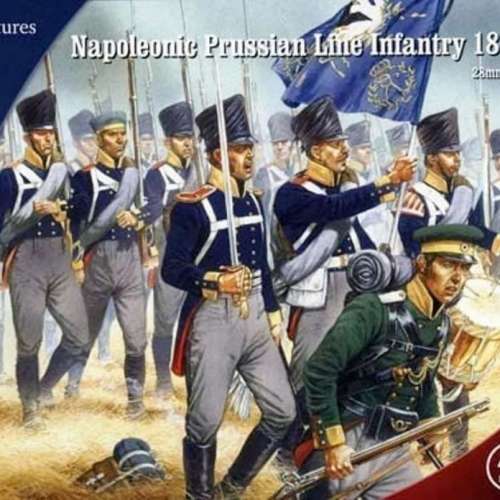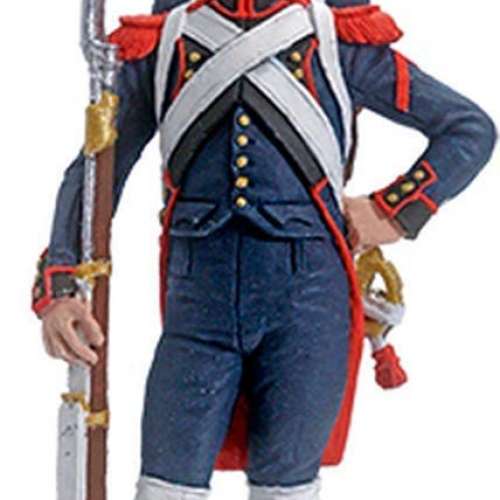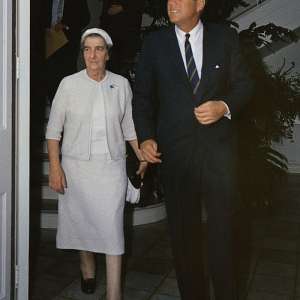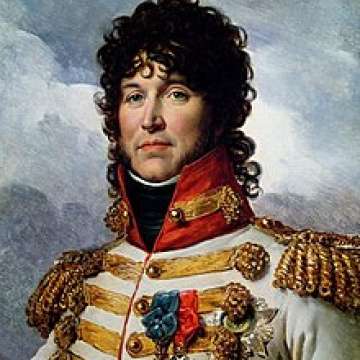

Joachim Murat (1767-1815)

"Soldiers! Do your duty! Straight to the heart but spare the face. Fire!"
Early life
Murat was born on 25 March 1767 in La Bastide-Fortunière renamed Labastide-Murat after its renowned citizen, in Guyenne present-day Lot department of France to Pierre Murat-Jordy d. 27 July 1799, an affluent yeoman innkeeper, postmaster and Roman Catholic churchwarden, and his wife Jeanne Loubières 1722 – 11 March 1806, daughter of Pierre Loubières and of his wife Jeanne Viellescazes. Pierre Murat-Jordy was the son of Guillaume Murat 1692–1754 and his wife Marguerite Herbeil d. 1755, paternal grandson of Pierre Murat b. 1634 and his wife Catherine Badourès d. 1697, and maternal grandson of Bertrand Herbeil and his wife Anne Roques.

Murat's parents intended that he pursue a vocation in the church, and he was taught by the parish priest, after which he won a place at the College of Saint-Michel at Cahors when he was ten years old. He then entered the seminary of the Lazarists at Toulouse, but when a regiment of cavalry passed through the city in 1787, he ran away and enlisted on 23 February 1787 in the Chasseurs des Ardennes, which the following year became known as the Chasseurs de Champagne, or the 12th Chasseurs. In 1789, an affair forced him to resign, and he returned to his family, becoming a clerk to a haberdasher at Saint-Ceré.
French Revolutionary Wars
By 1790, Murat had joined the National Guard, and the Canton of Montaucon sent him as its representative to the celebration of the first anniversary of Bastille Day la Fête nationale. He was subsequently reinstated in his former regiment. Because part of the 12th Chasseurs had been sent to Montmédy to protect the royal family on its flight to Varennes, the regiment had to defend its honor and loyalty to the Republic; Murat and the regiment's adjutant made a speech to the assembly at Toul to that effect. In 1792, Murat joined the Constitutional Guard, but left it that same year. His departure was attributed to various causes, including his constant quarreling and dueling, although he claimed he left to avoid punishment for being absent without leave.

An ardent Republican, Murat wrote to his brother in 1791 stating he was preoccupied with revolutionary affairs and would sooner die than cease to be a patriot. Upon his departure from the Constitutional Guard, he reported to the Committee of Surveillance of the Constitutional Assembly that the Guard was guilty of treason and that his lieutenant colonel, a man named Descours, had encouraged him to serve in the émigré army of Louis Joseph, Prince of Condé, then stationed in Koblenz. This garnered for him the support of the Republicans, for Murat rejoined his former regiment and was promoted to corporal in April that year, and later to sergeant in May. By 19 November 1792, Murat was 25-years-old and elated at his latest promotion. As a sous-lieutenant, he thought, his family must recognize that he had no great propensity for the priesthood, and he was hoping to prove that he had not been wrong in wishing to be a soldier. One of the ministers had accused him of being an aristocrat, confusing him with the noble family of Murat d'Auvergne, an accusation that continued to haunt him for the next several years.
13 Vendémiaire
In the autumn of 1795, three years after King Louis XVI of France was deposed, royalists and counter-revolutionaries organised an armed uprising. On 3 October, General Napoleon Bonaparte, who was stationed in Paris, was named commander of the French National Convention's defending forces. This constitutional convention, after a long period of emergency rule, was striving to establish a more stable and permanent government in the uncertain period following the Reign of Terror. Bonaparte tasked Murat with the gathering of artillery from a suburb outside the control of the government's forces. Murat managed to take the cannons of the Camp des Sablons and transport them to the centre of Paris while avoiding the rioters. The use of these cannons – the famous "whiff of grapeshot" – on 5 October allowed Bonaparte to save the members of the National Convention. For this success, Murat was made chef de brigade colonel and thereafter remained one of Napoleon's best officers.
Italian and Egyptian campaigns
In 1796, with the situation in the capital and government apparently stabilised and the war going poorly See also: French Revolutionary Wars, Bonaparte lobbied to join the armies attempting to secure the revolution against the invading monarchist forces. Murat then went with Bonaparte to northern Italy, initially as his aide-de-camp, and was later named commander of the cavalry during the many campaigns against the Austrians and their allies. These forces were waging war on France and seeking to restore the Bourbon monarchy. Murat's valour and daring cavalry charges later earned him the rank of general in these important campaigns, the battles of which became famous as Bonaparte constantly used speed of maneuver to fend off and eventually defeat individually superior opposing armies closing in on the French forces from several directions. Thus, Murat's skills in no small part helped establish Bonaparte's legendary fame and enhance his popularity with the French people.
Murat commanded the cavalry of the French Egyptian expedition of 1798, again under Bonaparte. In 1799, some remaining staff officers, including Murat, and Bonaparte returned to France, eluding various British fleets in five frigates. A short while later, Murat played an important, even pivotal, role in Bonaparte's "coup within a coup" of 18 Brumaire 9 November 1799, when he first assumed political power. Along with two others including Director Abbé Sieyès, Bonaparte set aside the five-man directory government, establishing the three-man French Consulate.

Murat married Caroline Bonaparte in a civil ceremony on 20 January 1800 at Mortefontaine and religious one on 4 January 1802 in Paris, thus becoming a son-in-law of Letizia Ramolino as well as brother-in-law to Napoleon Bonaparte, Joseph Bonaparte, Lucien Bonaparte, Elisa Bonaparte, Louis Bonaparte, Pauline Bonaparte, and Jérôme Bonaparte.
Napoleonic Wars
Napoleon made Murat a Marshal of the Empire on 18 May 1804, and also granted him the title of "First Horseman of Europe". He was made Prince of the Empire and Admiral of the Empire in 1805, despite having very little knowledge about naval warfare. After several territorial concessions made by Prussia, the Grand Duchy of Berg was set up, he was appointed Grand Duke of Berg and Duke of Cleves on 15 March 1806, and held this title until 1 August 1808, when he was named King of Naples. However, his transition would not be an easy one, seeing as Joseph Bonaparte, Napoleon’s brother and previous king, took many of the able-bodied soldiers and administrators with him. Murat was in charge of the French Army in Madrid when the popular Dos de Mayo Uprising that started the Peninsular War broke out.
Murat proved to be equally useful in the Russian campaign of 1812, where he distinguished himself as the best cavalry commander of the Grande Armee at battles such as Smolensk and Borodino, and expertly helped in commanding the retreat. He continued to serve Napoleon during the German Campaign of 1813. However, following Napoleon's defeat at the Battle of Leipzig, Murat reached a secret agreement with the Allies in order to save his own throne, raising 30,000 troops and switching sides to the Coalition; Napoleon was so shocked he refused to believe his best and most trusted cavalry commander would turn on him, blaming it on his sister Caroline, who was Queen of Naples.

During the Hundred Days, he soon realized that the European powers, meeting at the Congress of Vienna, intended to remove him and return the Kingdom of Naples to its pre-Napoleonic rulers. Murat deserted his new allies before the War of the Seventh Coalition and, after issuing a proclamation to Italian patriots in Rimini, moved north to fight against the Austrians in the Neapolitan War in order to strengthen his rule in Italy by military means. However, he was defeated by Austrian general Frederick Bianchi at the Battle of Tolentino 2–3 May 1815.
Death
Murat fled to Corsica after Napoleon's fall. He attempted to rejoin Napoleon and take up his post as commander of the Cavalry again, but doubting his loyalty Napoleon refused. So, with his around a thousand followers, he hoped to regain control of Naples by fomenting an insurrection in Calabria, a decision he would later regret when his former allies, whom he had deserted, campaigned for his arrest in Calabria. Arriving at the port of Pizzo with 200 men, Murat attempted to rally support in the town square, but his plan turned awry. The crowd was hostile and he was attacked by an old woman blaming him for the loss of her son.

Soon he was captured by forces of King Ferdinand IV of Naples. He was imprisoned in the Castello di Pizzo, a massive structure initially built as a fortress to fight off pirates, in the harbor of Pizzo, from where he wrote several letters, especially to his family. He was tried for treason and sentenced to death by firing squad.

On 13 October, King Ferdinand, under the advice of the British ambassador to Naples, William à Court, issued a decree by which "the condemned shall be granted not more than half an hour for the reception of religious aid."
- Castello di Pizzo, Murat's place of imprisonment and execution
- Murat's death sentence, as shown in the Naples State Archive
- Murat met death fearlessly, taking the shots standing and un-blindfolded.
- Murat's grave in Père Lachaise Cemetery, Paris
Children
Murat and Caroline had four children:
- Achille Charles Louis Napoléon Murat, Hereditary Prince of Berg, Prince of Naples, 2nd Prince Murat Paris, 21 January 1801 – Jefferson County, Florida, 15 April 1847, m. Tallahassee, Florida, 12 July 1826 Catherine Daingerfield Willis near Fredericksburg, Virginia, 17 August 1803 – Tallahassee, Florida, 7 August 1867, daughter of Colonel Byrd C. Willis 29 August 1781 – 1846 and wife Mary Lewis, and great-grandniece of George Washington, without issue
- Princess Marie Letizia Josephine Annonciade Murat [it] Paris, 26 April 1802 – Bologna, 12 March 1859, m. Venice, 27 October 1823 Guido Taddeo Pepoli, Marchese Pepoli, Conte di Castiglione Bologna, 7 September 1789 – Bologna, 2 March 1852, and had issue
- Lucien Charles Joseph Napoléon Murat, 2nd Sovereign Prince of Pontecorvo, 3rd Prince Murat Milan, 16 May 1803 – Paris, 10 April 1878, m. Bordentown, New Jersey, 18 August 1831 Caroline Georgina Fraser Charleston, South Carolina, 13 April 1810 – Paris, 10 February 1879, daughter of Thomas Fraser and wife Anne Lauton, and had issue; he was an associate of his first cousin Napoleon III of France. Ancestor of René Auberjonois
- Princess Louise Julie Caroline Murat Paris, 21 March 1805 – Ravenna, 1 December 1889, m. Trieste, 25 October 1825 Giulio Conte Rasponi [it] Ravenna, 19 February 1787 – Florence, 19 July 1876 and had issue
Relatives
Murat had a brother named Pierre La Bastide-Fortunière, 27 November 1748 – La Bastide-Fortunière, 8 October 1792, who married at La Bastide-Fortunière on 26 February 1783 Louise d'Astorg La Bastide-Fortunière, 23 October 1762 – 31 May 1832, daughter of Aymeric d'Astorg, born in 1721, and wife Marie Alanyou, paternal granddaughter of Antoine d'Astorg, born 18 November 1676, and wife Marie de Mary 4 May 1686 – 7 October 1727 and maternal granddaughter of Jean Alanyou and wife Louise de Valon.
His other brother André 1760–1841 was made 1st Count Murat in 1810.
Pierre and Louise were the parents of Marie Louise, Pierre Adrien d. 1805, Marie Radegonde d. 1800, Thomas Joachim and Marie Antoinette Murat, whom Emperor Napoleon I arranged to marry Charles, Prince of Hohenzollern-Sigmaringen; Karl III and Marie were the parents of Charles Anthony, Prince of Hohenzollern from whom descended Stephanie of Hohenzollern-Sigmaringen Queen of Portugal; her brother Carol I of Romania and her nephew Albert I of Belgium.
Another descendant of note is his great-great-great-grandson, American actor René Auberjonois.
More facts
Marie Letizia Josephine Annonciade Murat
Lucien Charles Joseph Napoléon Murat
Louise Julie Caroline Murat


